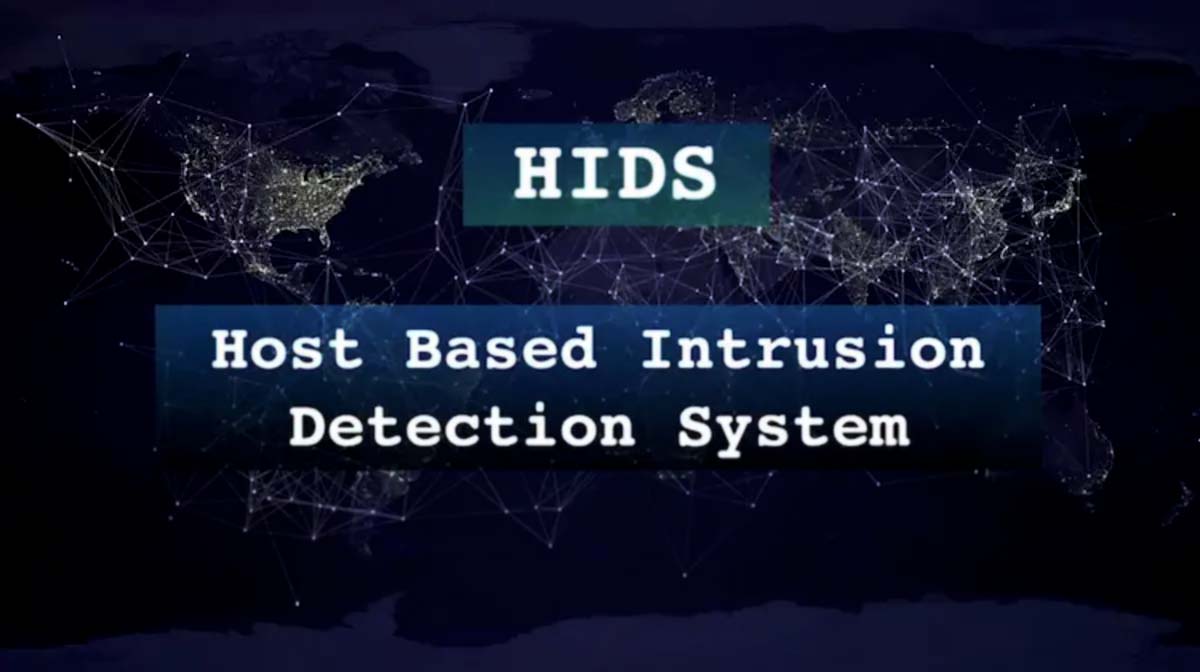Home>Home Security and Surveillance>What Is True Of A Host-Based Intrusion Detection System (HIDS)?


Home Security and Surveillance
What Is True Of A Host-Based Intrusion Detection System (HIDS)?
Modified: March 6, 2024
Discover the benefits of a Host-Based Intrusion Detection System (HIDS) for enhanced home security and surveillance. Ensure your peace of mind with proactive threat detection and prevention.
(Many of the links in this article redirect to a specific reviewed product. Your purchase of these products through affiliate links helps to generate commission for Storables.com, at no extra cost. Learn more)
Introduction
In today’s digital age, ensuring the security of our homes and personal belongings has become a top priority. As crime rates rise and criminals become more sophisticated, it is essential to have a reliable and effective home security and surveillance system in place. One component that plays a crucial role in safeguarding our homes is a host-based intrusion detection system (HIDS).
A host-based intrusion detection system, or HIDS, is a software-based security solution designed to monitor and protect individual devices within a network. It acts as a surveillance system, constantly scanning for signs of unauthorized access or malicious activity. Unlike a network-based intrusion detection system (NIDS), which monitors network traffic, a HIDS focuses on the individual host, such as a computer or server, and detects any suspicious behavior that might indicate an intrusion.
The primary purpose of a HIDS is to provide real-time monitoring and detection capabilities, allowing homeowners to mitigate security threats proactively. By analyzing log files, system events, and network traffic on the host, a HIDS can identify and alert you to any potentially malicious activities, such as unauthorized login attempts, file system modifications, or unusual network connections. With this information at hand, you can take immediate action to prevent further damage or unauthorized access to your home network.
Furthermore, a HIDS enables homeowners to gain valuable insights about their network security posture. By analyzing the patterns and trends of detected threats, you can identify potential vulnerabilities in your system and take proactive measures to strengthen your security defenses. This proactive approach helps safeguard your sensitive information, personal data, and assets from potential security breaches and intrusion attempts.
In this article, we will explore the key features, benefits, and limitations of using a host-based intrusion detection system. We will also delve into the different types of HIDS technologies, how they work, and common techniques and algorithms used in HIDS. Additionally, we will discuss typical use cases for implementing a HIDS and provide best practices for its implementation and maintenance.
By the end of this article, you will have gained a comprehensive understanding of host-based intrusion detection systems and how they can enhance the security of your home. So, let’s dive in and explore the world of HIDS!
Key Takeaways:
- A host-based intrusion detection system (HIDS) acts like a security guard for individual devices in a network, constantly watching for any unusual activities that might signal a security threat.
- HIDS helps protect homes and organizations by detecting potential security breaches early, providing real-time alerts, and ensuring that security incidents are investigated and addressed promptly.
Definition of a Host-Based Intrusion Detection System (HIDS)
A host-based intrusion detection system (HIDS) is a software solution that protects individual devices, such as computers and servers, by monitoring and analyzing their activity for signs of unauthorized access or malicious behavior. It focuses on the host itself, rather than network traffic, to identify and alert users about potential security threats.
HIDS operates by deploying agents or sensors on individual hosts, continuously monitoring and analyzing various system activities and resources. These activities include log file analysis, system call monitoring, file integrity checking, and network traffic analysis, among others. By scrutinizing these activities, a HIDS can detect any deviations from normal behavior that may indicate a security breach or an attempted intrusion.
One of the primary functions of a HIDS is to establish a baseline or profile of the host’s normal behavior. Through ongoing monitoring and analysis, it compares current activity patterns against this baseline to identify any deviations or anomalies. For example, if there is unusual network traffic or an unexpected modification to critical system files, the HIDS will trigger an alert to prompt further investigation.
To enhance its detection capabilities, a HIDS utilizes a combination of signature-based and anomaly-based detection techniques. Signature-based detection involves comparing system activities against a database of known attack patterns or signatures. If a match is found, it indicates a potential security threat. Anomaly-based detection, on the other hand, focuses on detecting abnormal behavior patterns that do not match any known attack signatures. This technique helps identify previously unseen or zero-day attacks.
A HIDS can be used as a standalone security solution or as part of a comprehensive security strategy alongside other security measures such as firewalls, antivirus software, and network intrusion detection systems (NIDS). By providing an additional layer of defense on each individual host, a HIDS helps ensure that security breaches are detected and addressed quickly, reducing the risk of unauthorized access and data loss.
It is important to note that while a HIDS is effective at detecting and alerting users about potential security threats, it does not prevent attacks from happening. Its main role is to provide real-time monitoring, early detection, and notification capabilities. Once an alert is triggered, it is up to the user or security team to investigate and respond to the incident accordingly.
With the ever-evolving nature of cyber threats, a host-based intrusion detection system is a vital component of a comprehensive home security and surveillance system. By actively monitoring and analyzing the activities on individual hosts, a HIDS helps homeowners detect and respond to security incidents promptly, strengthening overall network security.
Purpose and Scope of a HIDS
The primary purpose of a host-based intrusion detection system (HIDS) is to detect and respond to potential security breaches or unauthorized access on individual hosts within a network. By continuously monitoring and analyzing the activities and resources of these hosts, a HIDS helps protect against various threats, including malware infections, hacking attempts, and insider attacks.
The scope of a HIDS extends to all devices connected to a network, such as computers, servers, and IoT devices. It can be implemented in both home and enterprise environments to ensure the security and integrity of the systems and data stored on these hosts.
There are several key objectives that a HIDS aims to achieve:
- Real-time Monitoring: A HIDS provides continuous real-time monitoring of host activities, including log files, system events, file modifications, and network traffic. This helps identify any suspicious or unauthorized activities that may indicate an intrusion.
- Early Detection: By analyzing patterns and comparing them to established baselines, a HIDS can detect and alert users about potential security threats at an early stage. This enables timely investigation and response, reducing the potential impact of an attack or breach.
- Prevention of Unauthorized Access: A HIDS can detect attempts at unauthorized access to a host, such as failed login attempts or brute force attacks. It can also monitor changes to user privileges and access control settings, ensuring that only authorized users have access to sensitive resources.
- Identification of Malware: With its ability to monitor file system modifications and analyze network traffic, a HIDS can help identify and mitigate the presence of malware on a host. This includes detecting and alerting users about known malware signatures as well as anomalous behavior that may indicate the presence of zero-day or unknown threats.
- Compliance and Auditing: A HIDS helps organizations meet compliance requirements by providing detailed logs and reports of host activities. This allows for thorough auditing and analysis of security incidents, as well as demonstrating adherence to industry regulations and standards.
- Enhanced Incident Response: By providing real-time alerts and detailed information about potential security incidents, a HIDS facilitates effective incident response. This enables security teams to quickly investigate and mitigate the impact of an attack, minimizing downtime and potential data loss.
Overall, the purpose and scope of a host-based intrusion detection system revolve around proactively monitoring and protecting individual hosts within a network. By detecting and responding to potential security threats in a timely manner, a HIDS significantly strengthens the overall security posture of a home or organization, safeguarding valuable data and resources from unauthorized access and malicious activities.
Key Features of a HIDS
A host-based intrusion detection system (HIDS) offers a range of features designed to enhance the security of individual hosts within a network. These features enable the HIDS to effectively monitor and detect potential security breaches, providing users with real-time alerts and valuable insights. Here are some key features commonly found in a HIDS:
- Log File Monitoring: A HIDS analyzes log files generated by the host’s operating system, applications, and services. By monitoring and filtering log entries, it can detect any suspicious activities or unauthorized access attempts. This helps identify potential security breaches at an early stage.
- System Call Monitoring: HIDS monitors system calls made by applications and processes running on the host. It inspects the system call parameters and behavior to detect any malicious or abnormal activity. This feature is particularly effective in detecting attacks that exploit vulnerabilities in the operating system or applications.
- File Integrity Checking: HIDS verifies the integrity of critical system files and configurations by comparing them against known good versions or cryptographic checksums. It detects any unauthorized modifications or tampering of these files, which could indicate an intrusion attempt or the presence of malware.
- Network Traffic Analysis: A HIDS captures and analyzes network traffic at the host level, monitoring inbound and outbound connections. It identifies abnormal network behavior, such as unusual traffic patterns or connections to suspicious IP addresses, which may indicate a network-based intrusion or malware communication.
- Anomaly Detection: A HIDS employs anomaly detection techniques to identify deviations from normal behavior. By establishing a baseline of the host’s typical activities, it can detect unusual system behavior, such as excessive privilege escalation, unauthorized access attempts, or abnormal resource usage.
- Signature-Based Detection: HIDS uses a signature database that contains known attack patterns or signatures. It compares system events and activities against this database to identify matches. This technique is useful for detecting known attacks, malware, and common exploitation methods.
- Behavioral Analysis: HIDS employs behavioral analysis to identify suspicious behaviors that may not have a known signature. It analyzes the sequence of events, resource access patterns, and correlations to identify potential security threats. This helps detect zero-day attacks and novel attack techniques.
- Alerting and Reporting: When a potential security incident is detected, a HIDS generates real-time alerts to notify system administrators or security teams. The alerts include detailed information about the event, facilitating swift investigation and response. The HIDS also generates comprehensive reports that summarize detected events and provide insights for further analysis.
- Centralized Management and Administration: Some HIDS solutions provide centralized management and administration capabilities. This allows system administrators to configure and manage multiple HIDS agents from a centralized console, streamlining security operations and ensuring consistency across the network.
These key features enable a host-based intrusion detection system to actively monitor and safeguard individual hosts from potential security threats. By providing real-time alerts, detecting known and unknown attacks, and analyzing system activities, a HIDS significantly enhances the security posture of a home or organization and helps mitigate the risks associated with unauthorized access and malicious behavior.
Advantages and Benefits of Using a HIDS
Implementing a host-based intrusion detection system (HIDS) offers numerous advantages and benefits that contribute to the overall security and protection of individual hosts within a network. Here are some key advantages and benefits of using a HIDS:
- Early Detection of Security Threats: A HIDS actively monitors and analyzes system activities, allowing for the early detection of potential security threats. By promptly identifying unauthorized access attempts, malware infections, or abnormal behaviors, a HIDS provides an opportunity to mitigate the risks before they can cause significant damage.
- Real-Time Alerting: When a potential security incident is detected, a HIDS generates real-time alerts, notifying system administrators or security teams. These alerts provide immediate visibility into the event, enabling swift investigation and response. Real-time alerting helps minimize the impact of security breaches and facilitates timely incident management.
- Comprehensive System Monitoring: A HIDS offers comprehensive monitoring capabilities, analyzing various aspects of a host’s activity, such as file modifications, log events, network traffic, and system calls. This holistic approach provides a deeper understanding of potential vulnerabilities and security weaknesses, allowing for proactive security measures.
- Enhanced Incident Response: With its real-time alerting and comprehensive monitoring features, a HIDS significantly improves incident response capabilities. By providing detailed information about potential security incidents, including the origin and nature of the event, a HIDS facilitates quick and efficient incident investigation and remediation.
- Identification of Zero-Day Attacks: A HIDS utilizes behavioral analysis and anomaly detection techniques to identify previously unseen or zero-day attacks. This capability enables organizations to detect and respond to novel attack techniques that have not yet been identified or included in signature-based detection systems.
- Protection Against Insider Threats: A HIDS helps protect against insider threats by monitoring and analyzing user activity on individual hosts. It can detect unusual or unauthorized behavior, such as unauthorized access attempts or data exfiltration, helping organizations identify and prevent potential insider attacks.
- Meeting Compliance Requirements: Many regulatory frameworks and industry standards require organizations to implement intrusion detection systems as part of their security measures. By deploying a HIDS, organizations can demonstrate compliance and adhere to data security and privacy regulations.
- Enhanced Network Security: By providing an additional layer of defense at the host level, a HIDS complements network-based security measures, such as firewalls and network intrusion detection systems. This multi-layered approach significantly strengthens overall network security, reducing the risk of unauthorized access and data breaches.
- Insightful Reports and Analysis: A HIDS generates comprehensive reports that summarize detected events and provide insights into system activities. These reports help identify patterns, trends, and potential vulnerabilities, enabling organizations to improve their security posture and implement proactive measures to safeguard their hosts and data.
- Cost-Effective Security Solution: Implementing a HIDS can be a cost-effective security solution compared to other security measures, such as deploying physical security guards or investing in sophisticated network infrastructure. It provides continuous monitoring and detection capabilities without significant hardware or infrastructure investments.
Overall, a host-based intrusion detection system offers valuable advantages and benefits, including early detection, real-time alerting, enhanced incident response, protection against insider threats, compliance adherence, and insightful analysis. By deploying a HIDS, organizations can strengthen their security defenses, protecting their valuable assets, data, and reputation from potential security breaches and unauthorized access attempts.
Limitations and Challenges of Implementing a HIDS
While a host-based intrusion detection system (HIDS) offers significant benefits for enhancing network security, there are also certain limitations and challenges associated with its implementation. Understanding these limitations is crucial for effectively utilizing a HIDS and managing its potential challenges. Here are some common limitations and challenges of implementing a HIDS:
- Overhead and Performance Impact: Running a HIDS on individual hosts can introduce additional overhead and impact system performance. The constant monitoring and analysis of various system activities require computational resources, which can lead to increased CPU and memory usage. This may become especially noticeable on resource-constrained devices or during high-traffic periods.
- False Positives and False Negatives: A HIDS may generate false positives by incorrectly identifying harmless activities as potential security threats. This can result in security teams investigating and responding to non-existent incidents, wasting valuable time and resources. Conversely, false negatives may occur when a HIDS fails to detect actual security breaches or malicious activities, leaving the network vulnerable to attacks.
- Complex Configuration and Maintenance: Configuring and maintaining a HIDS can be complex, particularly in larger environments with numerous hosts. Each host typically requires individual agent installation and configuration, which can be time-consuming and challenging to manage. Regular updates and maintenance tasks, such as keeping signature databases up to date, also require careful attention to ensure effective operation.
- Identification of Unknown Attacks: While a HIDS can detect known attacks through signature-based detection, its ability to identify unknown or novel attacks is more limited. An attacker using a previously unseen technique or exploiting vulnerabilities that have not yet been identified in signatures may go undetected by the HIDS until updated signatures or behavioral analysis models are available.
- Encryption and Encrypted Traffic: A significant challenge for HIDS is the monitoring of encrypted traffic. As encryption ensures the confidentiality of data, it also obscures the visibility of network activities for the HIDS. Monitoring encrypted traffic requires the use of additional tools or techniques, such as SSL inspection or deploying separate network-based intrusion detection systems to complement the HIDS.
- Resource Limitations: The effectiveness of a HIDS depends on the available resources on each host. If a host lacks sufficient resources, such as disk space or processing power, the HIDS’s ability to accurately monitor and analyze activities may be compromised. This can lead to missed security events or reduced overall detection capabilities.
- Evading Detection Techniques: Attackers continuously develop sophisticated techniques to evade detection by intrusion detection systems, including HIDS. They may attempt to obfuscate their activities, modify their attack patterns to bypass signature-based detection, or employ anti-forensic techniques to erase their tracks. Keeping pace with these evolving evasion techniques requires regular updates and adjustment of HIDS configurations.
- Privacy Concerns: The deployment of a HIDS raises privacy concerns, particularly in home environments. Monitoring activities and analyzing logs on individual hosts may inadvertently capture sensitive or personal information. Care must be taken to ensure compliance with privacy regulations and to appropriately safeguard the privacy of users while maintaining effective security measures.
Despite these limitations and challenges, a host-based intrusion detection system remains a valuable tool for detecting and responding to potential security threats on individual hosts. With proper configuration, regular maintenance, and a comprehensive security strategy that includes other security measures, organizations can effectively mitigate the risks and maximize the benefits offered by a HIDS.
Common Components of a HIDS
A host-based intrusion detection system (HIDS) comprises several key components that work together to monitor and protect individual hosts within a network. These components provide the necessary tools and functionalities to detect and alert users about potential security threats. Here are the common components of a HIDS:
- Agent or Sensor: The agent or sensor is a critical component of a HIDS. It is installed on each host and collects data related to system activities, log files, file integrity, network traffic, and other relevant events. The agent is responsible for monitoring and analyzing the host’s behavior against established baselines or attack patterns.
- Log File Analyzers: Log file analyzers are used to parse and analyze log files generated by the host’s operating system, applications, and services. They help identify patterns, anomalies, and potential security incidents by inspecting log entries. Log file analyzers can be configured to apply specific rules and filters to detect known attack patterns or suspicious activities.
- System Call Monitors: System call monitors capture and analyze system calls made by applications and processes running on the host’s operating system. By monitoring the parameters and behavior of system calls, they can detect abnormal or potentially malicious activities that may indicate an intrusion attempt or compromise in progress.
- File Integrity Checkers: File integrity checkers ensure the integrity of critical system files and configurations. They compare the current state of files against known good versions or cryptographic checksums. Any differences or modifications detected are flagged as potential security breaches or unauthorized changes, triggering alerts for further investigation.
- Network Traffic Analyzers: Network traffic analyzers capture and inspect inbound and outbound network traffic at the host level. They monitor the network connections made by the host and analyze the traffic for unusual or suspicious patterns. By identifying unexpected connections or communication with blacklisted IP addresses, they help detect network-based attacks or malware communication.
- Anomaly Detection Engines: Anomaly detection engines use machine learning algorithms or statistical models to establish baselines of normal behavior for a host. They continuously compare the current behavior of the host against these baselines and identify deviations or anomalies that may indicate potential security threats. Anomaly detection engines are effective in detecting previously unseen attacks or zero-day vulnerabilities.
- Signature Databases: Signature databases contain known attack patterns or signatures that are compared against system events, log entries, or network traffic to identify matches. Signature-based detection is effective in detecting known attacks or malware, as it relies on a database of previously identified security threats. Regular updates and maintenance of the signature database are crucial to maintaining its effectiveness.
- Alerting and Reporting: A HIDS includes an alerting and reporting mechanism to notify system administrators or security teams about potential security incidents. When a suspicious activity is detected, an alert is generated, providing details about the event and recommended actions. The HIDS also generates comprehensive reports summarizing detected events, trends, and analysis for further investigation.
- Management Console: Some HIDS solutions provide a centralized management console for configuring, deploying, and managing the HIDS across multiple hosts. The management console allows system administrators to centrally manage agents, configure detection rules, review alerts, and generate reports. This simplifies the administration and monitoring of the HIDS infrastructure.
- Integration with Security Information and Event Management (SIEM) System: A HIDS can integrate with a SIEM system, which consolidates and correlates security event information from various sources. Integrating HIDS with a SIEM system provides a central point for aggregating and analyzing security events across the network, enabling comprehensive threat detection and incident response.
These common components work in tandem to provide comprehensive monitoring, detection, and alerting capabilities for individual hosts within a network. By leveraging these components, a host-based intrusion detection system enhances the overall security posture and helps protect against potential security breaches and unauthorized access attempts.
Tip: A HIDS monitors activities on a single host, like a computer or server, for signs of unauthorized access or malicious behavior. It’s important to keep HIDS software updated to effectively detect and respond to potential threats.
Different Types of HIDS Technologies
Host-based intrusion detection system (HIDS) technologies encompass various approaches and techniques to detect and mitigate potential security threats on individual hosts within a network. These technologies employ different methods and algorithms to monitor and analyze host activities. Here are some of the different types of HIDS technologies:
- Signature-Based Detection: Signature-based detection, also known as rule-based detection, relies on a database of known attack patterns or signatures. The HIDS compares system events, log entries, or network traffic against these signatures to identify matches. This technique is effective for detecting known attacks and malware but may struggle with zero-day or previously unseen attacks.
- Anomaly-Based Detection: Anomaly-based detection focuses on detecting activities or behaviors that deviate from established baselines of normal behavior. It monitors and analyzes various host activities, such as file modifications, system calls, and network traffic, to identify anomalous patterns. This technique is useful for detecting zero-day attacks, novel attacks, or abnormal behaviors not captured by signature-based detection.
- Heuristic-Based Detection: Heuristic-based detection goes beyond signature-based or anomaly-based detection. It employs a set of predefined rules or heuristics that represent known attack techniques or behavior patterns. The HIDS uses these rules to analyze system activities and detect potential security threats. Heuristic-based detection can be effective in identifying complex attacks or sophisticated evasion techniques.
- Machine Learning-Based Detection: Machine learning-based detection involves training algorithms on large datasets to classify normal and malicious behaviors. These algorithms learn from patterns and identify anomalies in real-time system activities. Machine learning techniques, such as supervised learning, unsupervised learning, or deep learning, can enhance the accuracy and effectiveness of intrusion detection by adapting to new and evolving attack techniques.
- Sandboxing: Sandboxing creates a controlled environment in which applications or processes are executed to analyze their behavior and identify potential threats. A HIDS can utilize sandboxing techniques to monitor and analyze suspicious files or processes in an isolated environment. This helps identify malicious activities or behaviors that may not be detected by traditional detection methods.
- Integrity Monitoring: Integrity monitoring focuses on verifying the integrity of critical system files and configurations. It compares the current state of files and configurations against known good versions, cryptographic checksums, or digital signatures. Any modifications or tampering detected imply potential security breaches or unauthorized changes.
- Network Behavior Analysis (NBA): NBA examines the network traffic patterns and behaviors of hosts to identify anomalies and potential security threats. It analyzes incoming and outgoing connections, network protocols, bandwidth usage, and other network-related metrics to detect suspicious activities or communications. NBA helps identify network-based attacks, lateral movement, or communication with malicious entities.
- Log Analysis: Log analysis involves the examination of log files generated by the host’s operating system, applications, or services. It aims to identify patterns, anomalies, or indicators of compromise within the logs. By analyzing system events, user activities, authentication logs, and other log entries, a HIDS can detect potential security incidents or unauthorized access attempts.
It is important to note that different HIDS technologies can be combined and integrated to enhance the detection capabilities and effectiveness of the system. Leveraging a combination of signature-based, anomaly-based, heuristic-based, and machine learning-based technologies offers a comprehensive approach to detect and respond to a wide range of security threats on individual hosts.
Each HIDS technology has its strengths and weaknesses, and the choice of technology depends on individual requirements, the level of threat sophistication, and the resources available for deployment and maintenance. Organizations may adopt multiple HIDS technologies to address different types of threats and improve overall security posture.
How a HIDS Works
A host-based intrusion detection system (HIDS) operates by monitoring and analyzing the activities and behaviors of individual hosts within a network. By examining system events, log files, file integrity, network traffic, and other relevant factors, a HIDS can detect potential security threats and alert users about unauthorized access or malicious behavior. Here is a breakdown of how a HIDS works:
- Agent Installation: The HIDS agent, responsible for data collection and analysis, is installed on each host within the network. This agent can be deployed manually or automatically depending on the HIDS implementation. Once installed, the agent begins monitoring system activities.
- Data Collection: The HIDS agent collects a range of data from the host, such as system events, log files, file system information, network traffic, and other relevant metrics. This data provides a comprehensive view of the host’s activities and facilitates the detection of security threats.
- Baseline Establishment: To detect anomalies, the HIDS establishes a baseline or profile of normal behavior for each host. The baseline captures typical activities, resource utilization, and behavior patterns. It serves as a reference point against which the HIDS can compare the host’s current activities.
- Behavior Monitoring: Once the baseline is established, the HIDS continuously monitors the behavior of the host. It analyzes system events, log files, file modifications, system calls, network traffic, and other relevant activities. This monitoring enables the detection of any deviations or abnormalities that may indicate a security breach.
- Anomaly Detection: Using various detection techniques, such as statistical analysis, heuristic algorithms, or machine learning models, the HIDS identifies anomalies in the host’s behavior. It compares the current behavior to the established baseline and looks for patterns or behaviors that fall outside normal parameters. Detected anomalies are flagged as potential security threats.
- Signature Matching: In addition to anomaly detection, the HIDS may employ signature-based detection. It compares the activities, events, or network traffic against a database of known attack patterns or signatures. If a match is found, it indicates a potential security threat based on known attack techniques.
- Alert Generation: When the HIDS detects a potential security threat, it generates an alert. The alert includes detailed information about the detected event, such as the type of activity, the host involved, and any relevant contextual information. The HIDS may assign a severity level to the alert based on the assessed risk.
- Alert Notification: The generated alerts are typically sent to system administrators or security teams for further investigation and response. The HIDS can send alerts through various means, such as email notifications, SMS messages, or integration with a security information and event management (SIEM) system.
- Response and Incident Management: Once an alert is received, the appropriate response and incident management procedures are initiated. This may involve analyzing the incident, determining the impact, and taking corrective actions to mitigate the threat. Incident response teams investigate the alert to understand the nature of the incident and implement appropriate countermeasures.
- Logging and Reporting: The HIDS logs relevant information about detected events for auditing and reporting purposes. It generates comprehensive reports that summarize the detected activities, anomalies, and alerts. These reports provide valuable insights into the security posture of the hosts and can help in identifying trends or areas for improvement.
By continuously monitoring and analyzing the activities of individual hosts, a HIDS plays a crucial role in detecting potential security breaches and mitigating threats. Its ability to establish baselines, detect anomalies, apply signature matching, and generate alerts enables organizations to respond efficiently to security incidents, protect their systems, and safeguard sensitive data.
Common Techniques and Algorithms Used in HIDS
A host-based intrusion detection system (HIDS) utilizes various techniques and algorithms to effectively detect and analyze potential security threats on individual hosts. These techniques and algorithms help identify anomalies, deviations from normal behavior, and known attack patterns. Here are some common techniques and algorithms used in HIDS:
- Anomaly Detection: Anomaly detection is a technique used to identify behaviors or activities that deviate significantly from normal patterns. It involves establishing a baseline of normal behavior and comparing current activity against this baseline. Common anomaly detection algorithms include statistical approaches like clustering, regression, or density-based methods, as well as machine learning techniques such as unsupervised learning or clustering algorithms.
- Signature Detection: Signature-based detection involves comparing observed events or activities against a database of known attack patterns or signatures. If a match is found, it indicates a potential security threat. Signature detection relies on regularly updated signature databases to stay up-to-date with the latest known attacks or malware. Common algorithms used for signature detection include pattern matching, regular expressions, or string matching algorithms.
- Heuristics: Heuristics are rules or algorithms that represent known attack techniques or behaviors. HIDS applies these rules to analyze system events, log entries, or network traffic for indicators of compromise or suspicious behavior. Heuristic detection can be effective in identifying specific attack patterns or evasion techniques. The rules may be based on expert knowledge or derived from historical data. The effectiveness of heuristic-based detection depends on the quality and relevance of the rules defined.
- Machine Learning: Machine learning algorithms are increasingly used in HIDS to improve detection accuracy and handle complex and evolving threats. Supervised learning algorithms can be trained on labeled datasets to classify normal and malicious behaviors. Unsupervised learning algorithms, such as clustering or anomaly detection algorithms, can discover patterns or anomalies in system activities without prior knowledge of attack patterns. Deep learning algorithms, such as convolutional neural networks (CNNs) or recurrent neural networks (RNNs), can also be applied to analyze large and complex data sets for intrusion detection.
- Behavioral Analysis: Behavioral analysis involves analyzing the sequence of events, dependencies, or resource access patterns on the host to identify potential security threats. This technique focuses on understanding normal behavior and detecting deviations or outliers that may indicate an attack. This analysis can be performed using various algorithms, such as hidden Markov models (HMM), sequence alignment, or Bayesian networks.
- Log Analysis: Log analysis techniques are used to analyze log files generated by the host’s operating system, applications, or services. Log entries can be analyzed to detect patterns, anomalies, or indicators of compromise. Techniques such as pattern matching, keyword searching, or log correlation can help identify potential security incidents or unauthorized access attempts. Additionally, natural language processing (NLP) techniques can be employed to extract meaningful information and context from logs.
These techniques and algorithms form the foundation for effective intrusion detection in a host-based context. HIDS leverages combinations of these techniques, depending on the type of detection required and the available data. It is important to regularly update and fine-tune these techniques as new attack methods emerge and the threat landscape evolves.
By utilizing these common techniques and algorithms, HIDS enhances the detection capabilities, enabling proactive identification of potential security breaches, early incident response, and mitigation of threats on individual hosts within a network.
Typical Use Cases for a HIDS
A host-based intrusion detection system (HIDS) serves as a critical security measure in various use cases and environments. It provides real-time monitoring, detection, and alerting capabilities for individual hosts within a network. Here are some typical use cases where a HIDS proves invaluable:
- Enterprise Networks: In enterprise networks, HIDS helps protect critical systems and sensitive data from unauthorized access attempts, malware infections, and insider threats. It monitors the activities of servers, workstations, and other networked devices to detect any anomalous behavior, potential security breaches, or policy violations. HIDS ensures the integrity and confidentiality of data throughout the enterprise network infrastructure.
- Home Networks: With the increasing reliance on connected devices in homes, HIDS plays a crucial role in home network security. It monitors and protects individual devices, such as computers, smart TVs, or IoT devices, against unauthorized access attempts, malware infections, or potential privacy breaches. HIDS allows homeowners to have greater control and visibility over their network security, ensuring a safe digital environment for their families.
- Web Servers and Applications: Web servers and applications are frequent targets for cyber attacks. HIDS helps protect web servers by monitoring access logs, identifying potential SQL injections, cross-site scripting (XSS) attacks, or other web application vulnerabilities. It alerts administrators in real-time, allowing them to take appropriate action to prevent data breaches or service disruptions.
- Database Servers: HIDS provides critical security for database servers by monitoring access activities, detecting potential unauthorized access, and identifying suspicious queries or behavior. It helps organizations ensure the confidentiality and integrity of valuable data stored within databases, safeguarding against data breaches, unauthorized modifications, or exfiltration attempts.
- Compliance and Regulatory Requirements: Many industries have specific compliance and regulatory requirements regarding the monitoring and protection of data. HIDS helps organizations meet these requirements by providing continuous monitoring, detection, and alerting capabilities. It assists in auditing and demonstrating compliance with regulations such as HIPAA (Health Insurance Portability and Accountability Act), PCI DSS (Payment Card Industry Data Security Standard), or GDPR (General Data Protection Regulation).
- Cloud Environments: Cloud infrastructure introduces additional security challenges, and a HIDS is essential to enhance the security of virtual machines (VMs) and resources within cloud environments. It monitors and protects cloud-based systems, ensuring the integrity and security of data transmitted and stored in the cloud. HIDS provides visibility and control over the security of cloud-hosted applications and infrastructure.
- Intrusion Detection and Incident Response: HIDS plays a crucial role in intrusion detection and incident response. It detects potential security incidents, triggers real-time alerts, and provides valuable information to incident response teams. HIDS significantly reduces the time to detect and respond to security breaches, minimizing the impact of incidents and enabling organizations to effectively mitigate threats.
- Asset and Configuration Management: HIDS aids in asset and configuration management by providing insights into the activities and changes that occur on individual hosts. It helps maintain an accurate inventory of devices, detect unauthorized modifications, and enforce compliance with configuration policies. HIDS enhances overall asset management and ensures proper alignment with security standards and organizational policies.
These use cases highlight the versatility and significance of a host-based intrusion detection system in protecting networks, systems, and data. By providing continuous monitoring, real-time detection, and alerting capabilities, HIDS assists organizations in proactively identifying and mitigating potential security threats, ensuring a secure and resilient network infrastructure.
Best Practices for Implementing and Maintaining a HIDS
Implementing and maintaining a host-based intrusion detection system (HIDS) requires careful planning and adherence to best practices to ensure its effectiveness in detecting and mitigating potential security threats. Here are some best practices to consider when implementing and maintaining a HIDS:
- Define Clear Objectives: Clearly define the objectives and goals of implementing a HIDS. Understand the specific security requirements, compliance obligations, and the assets you aim to protect. This will help guide the selection and configuration of the HIDS to align with your organization’s needs.
- Choose the Right HIDS Solution: Conduct thorough research, evaluate different HIDS solutions, and choose the one that best fits your requirements. Consider factors such as accuracy, ease of deployment and maintenance, scalability, integration capabilities, and vendor support.
- Deploy Agents on All Critical Hosts: Install HIDS agents on all critical hosts within your network, including servers, workstations, and other devices. Ensure that coverage across the network is comprehensive, providing visibility into the activities of all hosts and crucial system resources.
- Establish Baselines: Take the time to establish baselines for each host to define normal behavior. Monitor and analyze the activities, resource usage, and network traffic patterns to establish accurate and up-to-date baselines. Regularly review and update baselines as system configurations change or new threats emerge.
- Regularly Update and Patch: Keep the HIDS agents, software, and signature databases up to date. Regularly apply patches and updates to ensure the HIDS is equipped to detect the latest threats and vulnerabilities. Also, keep the host operating systems and applications up to date to minimize potential security weaknesses.
- Configure Sensible Alerting: Fine-tune the alerting thresholds and settings to minimize false positives without sacrificing detection accuracy. Adjust the alerting parameters based on your organization’s risk tolerance and security incident response capabilities. Prioritize critical alerts to focus on the most significant threats.
- Establish an Incident Response Plan: Develop a thorough incident response plan that outlines the steps, roles, and responsibilities in the event of a security incident. Ensure that the incident response plan includes procedures to investigate HIDS alerts, assess the severity of incidents, and take appropriate actions to mitigate threats.
- Monitor and Analyze Logs and Alerts: Regularly review and analyze the logs and alerts generated by the HIDS. Actively monitor the alerts and investigate any suspicious activities or anomalies. Perform in-depth analysis of identified security incidents to understand their root causes and adjust security controls accordingly.
- Integrate with SIEM and Other Security Solutions: Integrate the HIDS with a centralized Security Information and Event Management (SIEM) system and other security solutions within your network. This facilitates comprehensive event correlation, centralized management, and streamlined incident response across multiple security tools.
- Perform Regular Audits and Assessments: Conduct periodic audits and assessments of the HIDS implementation to ensure its effectiveness. Review and validate the configuration settings, assess the coverage of the HIDS agents, and evaluate the overall performance. Perform vulnerability scans and penetration tests to identify any weaknesses in the HIDS deployment.
- Provide Ongoing Training and Education: Invest in continuous training and education for the personnel responsible for implementing and maintaining the HIDS. Ensure they stay up to date with the latest security threats, HIDS capabilities, and industry best practices. This will enhance their proficiency in effectively managing and optimizing the HIDS infrastructure.
By following these best practices, organizations can enhance the effectiveness of their host-based intrusion detection system and bolster their network security posture. Implementing a HIDS requires a proactive approach, regular maintenance, and continuous monitoring to adapt to evolving threats and effectively protect critical systems and data.
Conclusion
A host-based intrusion detection system (HIDS) is a crucial component of a comprehensive home security and surveillance system. By continuously monitoring and analyzing the activities of individual hosts within a network, a HIDS plays a vital role in detecting and responding to potential security threats.
In this article, we have explored the definition, purpose, and key features of a HIDS. We have discussed the advantages it offers, such as early threat detection, real-time alerting, and enhanced incident response. Additionally, we have addressed the limitations and challenges that come with implementing and maintaining a HIDS, such as performance impact and the need for regular updates.
We have also highlighted the common components of a HIDS, including agents or sensors, log file analyzers, system call monitors, and network traffic analyzers. These components work in tandem to provide a comprehensive security solution for individual hosts.
Furthermore, we have examined the different types of HIDS technologies, such as anomaly detection, signature-based detection, and machine learning-based detection. These technologies employ various techniques and algorithms to detect and mitigate potential security threats.
Typical use cases for a HIDS have been presented, demonstrating its applicability in enterprise and home networks, web servers, database servers, compliance adherence, cloud environments, intrusion detection, and incident response.
Lastly, we have provided best practices for implementing and maintaining a HIDS, emphasizing the importance of clear objectives, careful selection of the HIDS solution, agent deployment on critical hosts, baseline establishment, regular updates and patches, and ongoing monitoring and analysis. These best practices ensure the effectiveness of a HIDS in detecting and responding to security threats.
In conclusion, a host-based intrusion detection system is an essential tool for safeguarding individual hosts within a network. With its real-time monitoring, detection, and alerting capabilities, a HIDS enhances the overall security posture and aids in the early detection and response to potential security breaches. By implementing and maintaining a HIDS using best practices, organizations can mitigate risks, protect valuable assets, and maintain a secure environment in the face of evolving cyber threats.
Frequently Asked Questions about What Is True Of A Host-Based Intrusion Detection System (HIDS)?
Was this page helpful?
At Storables.com, we guarantee accurate and reliable information. Our content, validated by Expert Board Contributors, is crafted following stringent Editorial Policies. We're committed to providing you with well-researched, expert-backed insights for all your informational needs.













